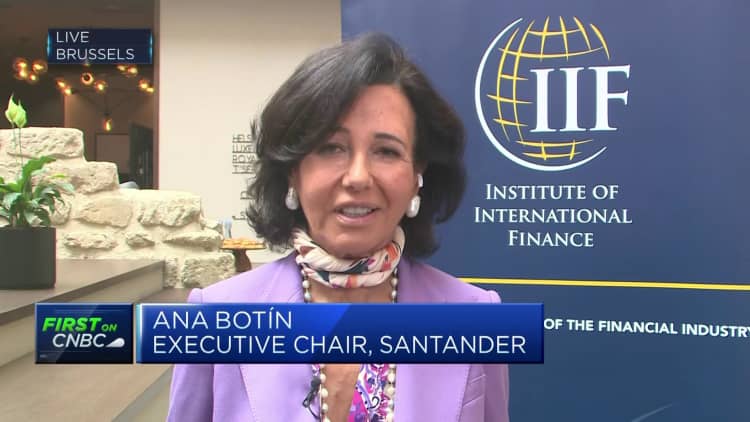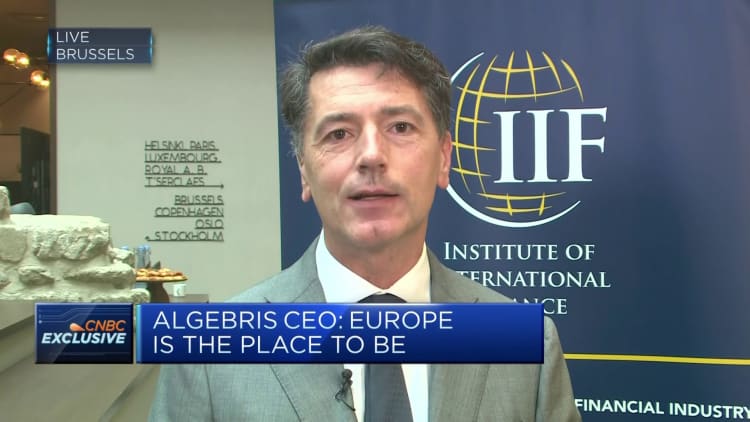[ad_1]
The Faro office building at the Banco Santander SA headquarters on Thursday, Feb. 2, 2023.
Bloomberg | Bloomberg | Getty Images
European banks are looking stronger and more attractive than their U.S. counterparts on many metrics, according to officials and analysts speaking at the Institute of International Finance conference in Brussels this week, who add that regulation and collaboration is still needed to boost growth in the region.
The biggest bank in the U.S. is worth what the top nine or 10 European banks are due to weaker growth and less profitability since the 2008 financial crisis, Ana Botín, executive chair of Spain’s Santander Group, told CNBC at the event on Tuesday.
However, the top European banks have better levels of credit default swaps, a form of insurance for a company’s bondholders against default, “which means that fixed income investors think the risk of our debt is lower than the best banks in the U.S.,” Botín added.
The recent volatility that led to the sale of Credit Suisse to UBS was not evidence of a systemic banking crisis, she said, but rather mismanagement and liquidity issues at specific banks.
“We are in a very strong position in terms of capital, liquidity supervision, protection of our customers’ data. But we also need a bit more capacity to support growth so we can be more profitable,” she said.
“What we need is a fundamental rethink of what do we want banks to be in the new economy in a world that needs growth. And finding that balance is really important between being prudent, we’re not saying that we should go back on that, but also being able to finance growth,” Botín continued, adding this would be a key theme at the IIF’s conference.
European banks are “safer, stronger, cheaper” than U.S. ones said Davide Serra, chief executive officer of Algebris Investments, who stressed the higher liquidity ratio of European banks — around 160% — versus 120% in the U.S.
“In a way, banks in the U.S. have been optimizing their deposit base more. And now with the Fed [Federal Reserve] keeping higher interest rates, people just want to get paid on their deposits. So they have options with money markets, or with moving cash around,” he said.

“At the same time in the U.S., people are being reminded that, you know, not all banks are born equal. And just because you have a sign called bank, you’re not as safe, as you know, JPMorgan, or Morgan Stanley.”
That will lead to further consolidation in the U.S., he said, following the series of regional bank collapses this year, with banks considered safe benefitting.
“Overall, I think the opportunity is clear. For the strong banks in Europe and in the U.S., with Europe much, much more attractive, there has been zero deposit outflow, zero issue … And hence, to be honest, after 10 years of restructuring, Europe I think is the place to be.”
Banking union delay
José Manuel Campa, chair of the European Banking Authority, noted low valuations of European banks, but said these had been improving amid wider sector turmoil and as higher interest rates boost their returns.
“I think that as interest rates rise, if [European banks] continue to show that their business model is sustainable, we should see enhancements over the medium term on those valuations as well,” he said.
For Campa, any further consolidation in European banking must be about creating better banks and “go along to fostering a more integrated single market in the European Union so we can have cross-border banking and more efficient services to European customers.”
The EU has a long-delayed plan to further develop its banking union, a set of laws introduced in 2014 to strengthen banks, to create a common system in deposit insurance and other areas. Talks are also ongoing over a Capital Markets Union.
Both Botín and Campa said pushing these tricky negotiations forward was important for the future of the sector, with Botín saying they could help boost European growth.

“There is one thing that we could do in Europe to have higher growth, which is securitization,” she said.
Creating new rules on securitization, the creation of tradeable securities from a group of assets — which remains a contested subject following the subprime mortgage crisis — is key to the EU’s proposed Capital Markets Union.
“The securitization market in Europe is 6% the size of the American market. Banks are no longer the best holders of credit,” Botín said.
“In many cases we can originate, we can help our customers raise that capital and then place it with other funds and other parties that are better holders. So there are a number of things around Capital Markets Union, for example, that could move faster and help higher growth,” Botín said.
[ad_2]

